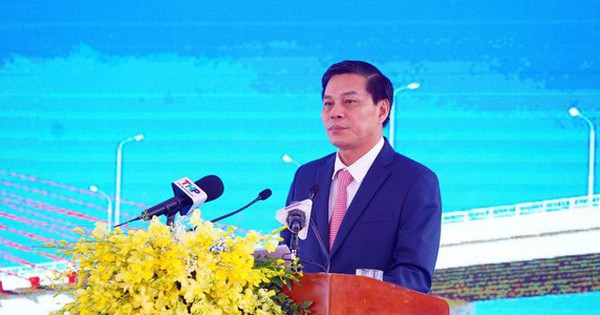Which routes will the seaport toll revenue be invested in?
Ho Chi Minh CityWith 16,000 billion VND from the port infrastructure fee, the projects of Ring 2, My Thuy intersection, Nguyen Thi Dinh road expansion… will be accelerated in the coming time.
From 0:00 on April 1, Ho Chi Minh City begins fee seaport infrastructure with the lowest fee of 15,000 VND per ton of goods not packed in containers (import and export goods are declared in Ho Chi Minh City); the highest is 4.4 million VND per 40-foot container (temporary import for re-export, bonded warehouse, border-gate transfer).

Major seaports in Ho Chi Minh City. Graphics: Bar suspension
By 2025, the port infrastructure fee is expected to reach about 16,000 billion VND. After deducting a part to the toll collector, the entire revenue will be invested in works around the port. This is part of a plan to supplement capital investment in routes connecting ports that have been delayed for many years due to lack of resources.
Mr. Bui Hoa An, Deputy Director of the Department of Transport, said that the above solution is considered “special” to soon complete the works, reducing traffic pressure around the seaport. Instead of blending into the budget and distributing it evenly, the port infrastructure fee is allocated separately to do port connection infrastructure projects, not investing in other areas. In front of eyes, By 2025, there are 14 projects prioritized to allocate capital from this source.
“The revenue of 16,000 billion VND only meets 17% of the total capital need for the above projects, but it will help speed up the progress of many urgent projects,” said Mr. An, adding that the investment was not spread out, but assessed. Priced according to priority for implementation, after completing this project, it will be transferred to another project.
According to the leader of the city’s Department of Transport, currently the new revenue source is in the calculation, so when determining more specifically, this unit proposes to do each project as well as the capital allocation plan. In which, the works around the port Cat Lai (accounting for nearly 50% of the national container import and export market share) will be the top priority of the toll collection scheme due to urgent requirements.

Traffic jams on Nguyen Thi Dinh Street, the section near Cat Lai port, on the morning of March 30. Photo: Gia minh
Specifically, in the area around Cat Lai port, Nguyen Thi Dinh street with about 20,000 vehicles entering and leaving the port every day will be expanded to 8 lanes from My Thuy to Cat Lai ferry, costing more than 1,100 billion VND. In addition, the city will focus on completing the intersection My Thuy roundabout, with the remaining items such as an overpass for vehicles to turn left in the direction from Cat Lai port to Phu My bridge; building Ky Ha 4 bridge…
Nearby, Nguyen Duy Trinh Street, the section from Ring 2 to Phu Huu port, was also expanded to 30 m, with an investment of more than 800 billion VND. At the same time, the city also built a new route from Cat Lai port to Phu Huu, 1.6 km long, 30 m wide, with a total investment of nearly 950 billion VND…
According to Mr. An, in the period to 2025, the city will prioritize investment capital in two phases Belt 2 via Thu Duc City, including the section from Phu Huu Bridge to Hanoi Highway (3.5 km long) and from Hanoi Highway to Pham Van Dong Street (2.8 km long), with a total cost of more than 17,000 billion VND. . When these projects are completed, they will create a new axis connecting Cat Lai, Phu Huu and Truong Tho port clusters. In addition to increasing the cargo handling capacity for ports, this road helps to separate channels and reduce congestion for the inner city.
At the Saigon port area (District 4), the project Thu Thiem Bridge 4 Also in the prioritized plan to reduce congestion at the Huynh Tan Phat – Luu Trong Lu – Nguyen Van Linh intersection. In addition, there are works to expand Luu Trong Lu road connecting Tan Thuan port (District 7) with Nguyen Van Linh street; study additional riverside routes to connect between ports along Soai Rap river…

Cars run on Huynh Tan Phat Street, District 7, at rush hour. Photo: Quynh Tran
“Most of the above projects are planned to be completed from 2020 but are still unfinished or cannot be implemented due to lack of capital. Therefore, early investment in the works will help businesses reduce difficulties and reduce logistics costs.” , Mr. An said.
According to the leader of the city’s Department of Transport, when the traffic situation improves, the delivery time is shortened, transport units and import-export businesses benefit more. The collection of seaport infrastructure fees also helps to channelize goods, share them with neighboring provinces such as Dong Nai, Long An, Binh Duong, Ba Ria – Vung Tau, reducing pressure on the infrastructure system of Ho Chi Minh City.
In the immediate future, when the above works have not been invested yet, the city is applying a number of solutions such as traffic separation, adjusting the time for vehicles to run, shortening customs clearance procedures… to reduce congestion. The city also has to “control” the exploitation capacity in the port. For example, at Cat Lai, it can accommodate 85 ships per week, but only 81 trains can be received. Phu Huu and Hiep Phuoc ports are currently only exploiting about 50% of their capacity due to incomplete investment in infrastructure.
Gia minh
at Blogtuan.info – Source: vnexpress.net – Read the original article here



